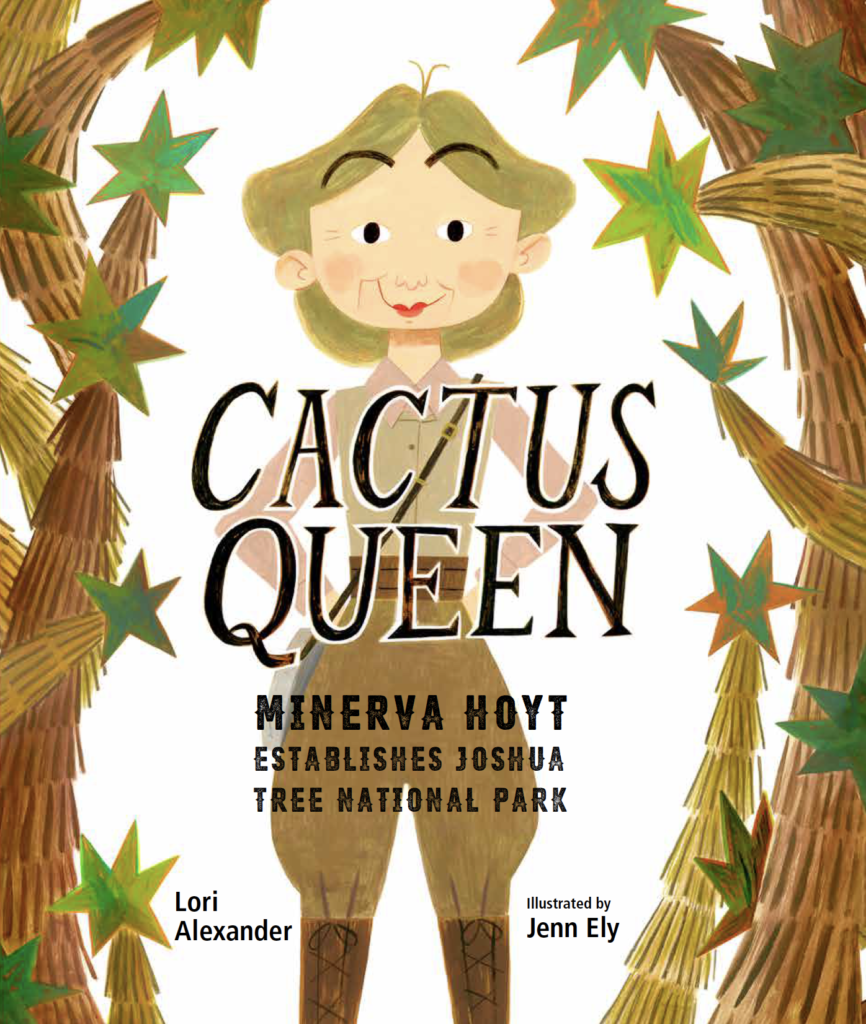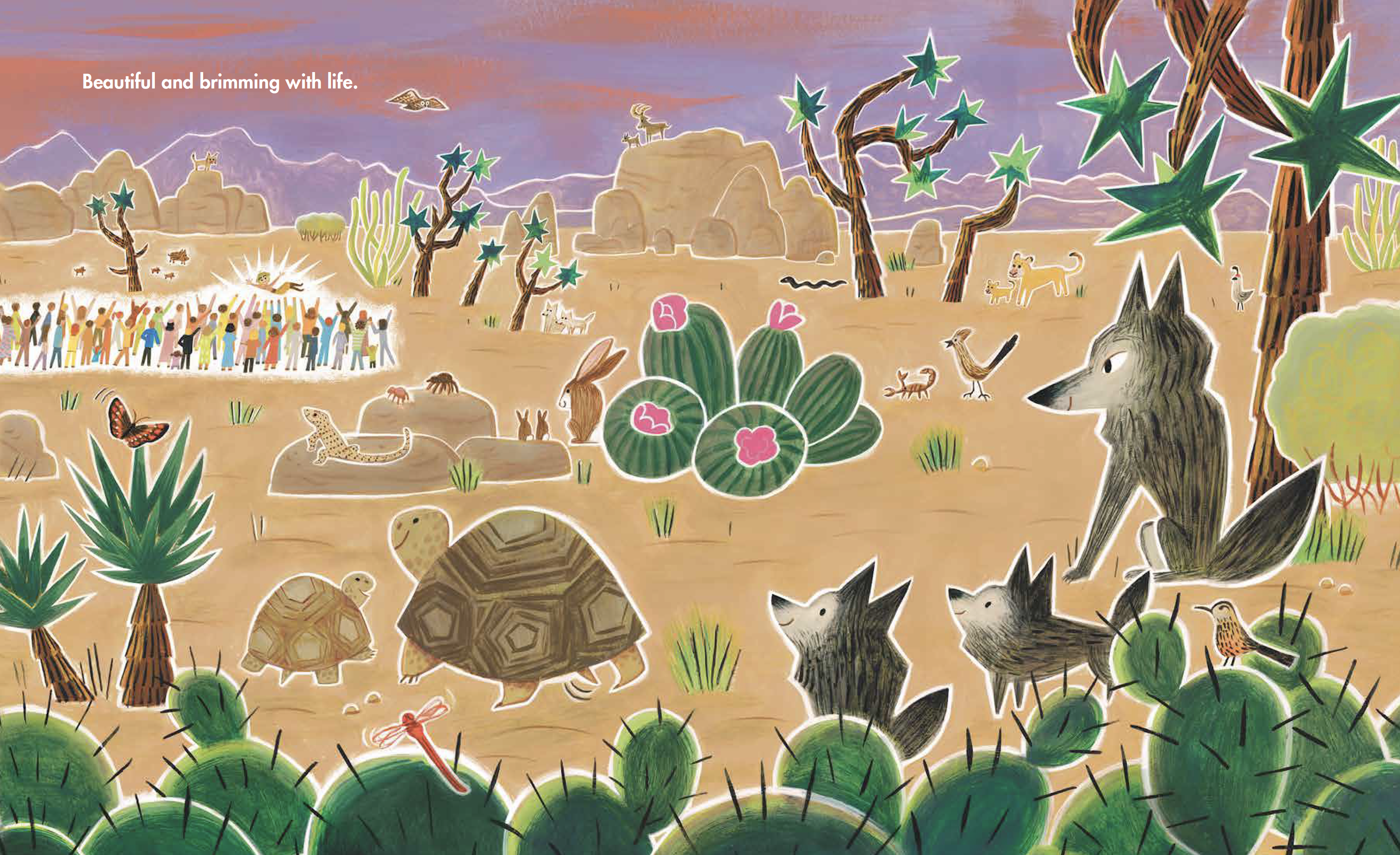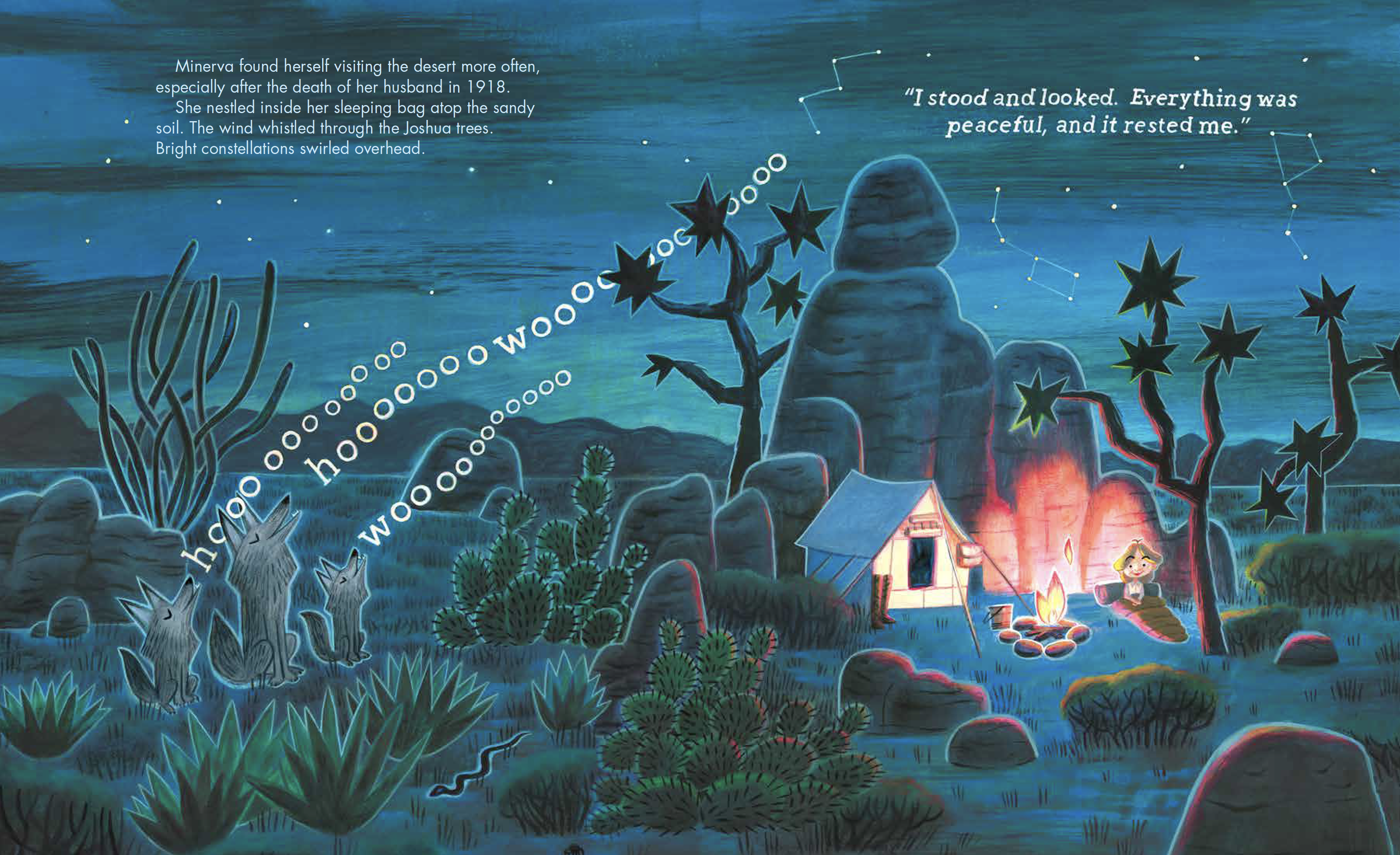
Calkins Creek | 978-1662680212
I love discovering books about people I have not heard of before, people who have made a significant difference yet whose contributions are largely unknown. Minerva Hoyt is one such woman. Her love of the Mojave Desert caused her to advocate on its behalf, eventually convincing President Franklin D. Roosevelt and the National Park Service that this desert was worth preserving.
On August 10, 1936, her efforts paid off when President Roosevelt signed a law creating the Joshua Tree National Monument, saving over 800,000 acres of the Mojave desert.

Minerva Hoyt Mural: Oasis Visitor Center
NPS/Robb Hannawacker (public domain)
CACTUS QUEEN, beautifully written by Sibert Honor and Junior Library Guild award-winning author Lori Alexander with charming illustrations by Jenn Ely powerfully captures Minerva Hoyt’s passion and persistance: “This desert… possessed me, and I constantly wished that I might find some way to preserve its natural beauty.” — Minerva Hoyt
I’m so pleased to welcome Lori to ReaderKidZ to share a little more about her newest book!
DIANNE: Welcome back to ReaderKidZ, Lori! Thanks for taking the time to answer a few questions.
You’ve written longer nonfiction for middle grade, including the Sibert Honor award winner, All in a Drop, but this is your first nonfiction picture book. One of the obvious differences between the two formats is length and the need to distill Minerva Hoyt’s personality and accomplishments in a way that is still relatable to the younger picture book audience. After writing two longer nonfiction books, did you find the picture book format easier or harder? In what ways?
LORI:I do love picture book biographies! The very best are able to paint vivid and lasting images of the remarkable lives of (typically lesser-known) historical figures. I hope I’ve accomplished that with Cactus Queen: Minerva Hoyt Establishes Joshua Tree National Park.
I don’t know if I’d call any category of children’s books easy to write, but in this case I did find the picture book format a bit simpler, as the length of this manuscript was closer to 1000-words instead of the 10,000+ words of a nonfiction chapter book. In addition, the content of this story felt right for a younger audience. While this book is listed for grades 2-5, even the kindergartners I saw at this year’s school visits were quick to understand the ideas of conservation, protecting the places you love, and caring for earth’s plants and animals. The chapter book format has its merits, too. In my previous books, I’ve used the extra space to show how daily life was different in the 1600s-1800s, the time periods when my historical figures lived. I added sidebars to dive deeper into their scientific discoveries, topics such as microbes, genes, and DNA. The majority of Cactus Queen takes place in the not-so-distant mid-1900s, and it doesn’t contain any advanced science concepts, so I found the picture book format perfect for telling Minerva’s story of passion and persistence.

DIANNE: Did research for this book differ significantly from the research you did for All In A Drop and What’s a Germ , Joseph Lister? If so, how?
LORI: The process was quite similar. Once I have a subject in mind, I do a deep dive online to find any posts or links to newspaper articles. I check the library for any books that have been written about, or even just mention the historical figure, and I read, read, read. I also reach out to historical societies and I search for archival photos (my biographies have all been illustrated but each includes a number of photographs, and the acquisition of photos falls to the author, not the illustrator). Finally, if it’s feasible, I travel to the site. In this case, the whole family came along on a trip to Joshua Tree National Park, where I was able to meet with the park’s archivist and education department to gather more information (and make contacts with the expert readers who would eventually fact-check my text).
DIANNE: It’s a powerful addition when an author is able to include quotes from their subject from primary source materials. Was it yours or your editor’s idea to weave quotes by Minerva Hoyt throughout the story?
LORI: My first nonfiction editor, Ann Rider, who is now retired, taught me that quotes from the historical figure “bring the text to life.” They were sprinkled throughout our works together: All in a Drop and A Sporting Chance and What’s a Germ, Joseph Lister? While I’m working with different editors and publishers now, I continued to include rich quotes throughout my texts, pulled from primary sources such as letters, interviews, and scientific papers. Cactus Queen begins with these words from Minerva: “This desert possessed me, and I constantly wished that I might find some way to preserve its natural beauty.” A great quote, as it also sets-up the story problem and Minerva’s motivation.
DIANNE: Jenn Ely’s illustrations are marvelous! Do you have a favorite?
LORI: Jenn’s illustrations are lovely! Many people think “dry wasteland” when they hear the word desert. But Jenn created such a vibrant scene of the Mojave’s varied plants and animals. I adore every page but especially the nighttime spread, where Minerva camps out with the Joshua trees, and the final spread, when Minerva wins her hard-fought battle to protect the region she loved so much.

DIANNE: What can your readers look forward to next?
LORI: I have another biography releasing in 2025 and I’m back to the chapter book format. It’s called Seeds of Discovery: How Barbara McClintock Used Corn and Curiosity to Solve a Science Mystery and Win a Nobel Prize. The title is long, as was Barbara’s quest to gain recognition in her field of genetics. It was wonderful to write about a female scientist and the fully-illustrated, colorful artwork by Rebecca Santos energize the entire manuscript. I can’t wait to share this one with budding scientists! I also signed a board book contract recently, a fun little rhymer—more details to come!
DIANNE: Oooh! More nonfiction, and another board book. Wonderful! Can’t wait to learn more. Thanks, again, for chatting about your picture book process!
 Nonfiction Bio:
Nonfiction Bio:
In addition to picture books, LORI ALEXANDER writes chapter books about the fascinating history of science and medicine. She won a Sibert Honor Award for All in a Drop: How Antony van Leeuwenhoek Discovered an Invisible World, and A Sporting Chance: How Ludwig Guttmann Created the Paralympic Games was named a Kirkus Reviews Best Book. Her recent release, What’s a Germ, Joseph Lister?: The Medical Mystery That Forever Changed the Way We Heal, is a Junior Library Guild Gold Standard Selection. Lori resides in Tucson, Arizona, with her scientist husband and two book-loving teens. lorialexanderbooks.com
Lori occasionally posts to IG: @lorialexanderbooks or Twitter: @LoriJAlexander
Peek into or purchase CACTUS QUEEN here.
Check out this 2021 ReaderKidZ interview with Lori










